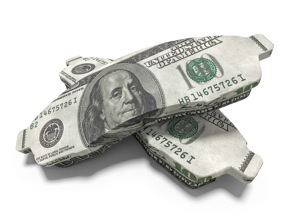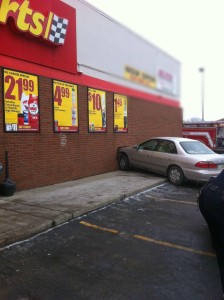 Why is everyone chasing the cheapest brake service or parts? It often seems that new-car dealers, chains and independent shops are locked in a race to the bottom when it comes to the common pad replacement.
Why is everyone chasing the cheapest brake service or parts? It often seems that new-car dealers, chains and independent shops are locked in a race to the bottom when it comes to the common pad replacement.
Some marketing pros see brake jobs as cheap appetizers or happy hour drink specials that get people in the door so that they spend money on entrees. The difference is a consumer has never needed to use an appetizer to keep their family safe.
We can all agree that no two vehicles or drivers are the same, so why give one price for all vehicles or even a uniform “starting at” price?
Price Shoppers
Shops that charge the cheapest prices for brake jobs do so for a few reasons, the most significant being they are afraid of costing more than the competition down the street. Some almost treat the brake job as a “loss leader” to get customers in the door so they can inspect the vehicle. While this might work for some retail businesses and service providers, it will not work for a traditional repair shop building long-term customer growth and profitability.
Cheap Brakes=Cheap Result
Most factory labor times call for 0.7 hours to replace the pads. To replace a rotor is about 0.1 to 0.2 hours, depending on the vehicle. With 0.9 hours to do the job right, the profit margins start to get thin. Most brake jobs finished in less than 0.9 hours require shortcuts that are not recommended by the OEMs. Some of these shortcuts might include not measuring for runout in the rotor or hub and not cleaning and lubricating the guide pin and slides.
Cheap Pads=Comebacks
To avoid losing money on a cheap brake job, compromises might need to be made when it comes to the pads and rotors. Cheap pads or rotors exist, but by cutting corners and installing these lackluster parts, you are drastically decreasing the life of the service, the safety of the driver and customer satisfaction.
Here are two reasons why your shop needs to use premium brake pads. First, there are more profit dollars in a more expensive premium brake pads when you do the usual parts mark up of 35-50%. Second, premium pads reduce comebacks that the technician and shop have to pay for when it happens.
Shops that perform cheap brake jobs are making a dangerous assumption that the average customer wants to sacrifice higher quality for the price. In my experience, this is rarely the case.
The Value of Integrity
 Brake pads require a great deal of testing and engineering because they are made for specific vehicles. A quality brake pad manufacturer will spend a lot of time and money developing a brake pad application. This includes simulated and on-the-vehicle testing. These types of tests are time- and equipment-intensive.
Brake pads require a great deal of testing and engineering because they are made for specific vehicles. A quality brake pad manufacturer will spend a lot of time and money developing a brake pad application. This includes simulated and on-the-vehicle testing. These types of tests are time- and equipment-intensive.
A brake dynamometer, for example, can be more sophisticated and larger than an engine dynamometer. Brake dynamometers can simulate the conditions the brake system will experience in a much shorter time than real-world testing. This means that a brake dynamometer can simulate the mass, inertia and performance capabilities of a given vehicle. The typical brake dynamometer can cost anywhere between $400,000 (used) to more than $1 million.
Cheap brake pad lines will use fewer friction formulations to simplify production. For these cheap lines, the same friction formulation for a Ford F-250 could be used on a Honda Civic. Cheap brake lines will use the least expensive materials for the shim, hardware and backing plate. The backing plate may use the thinnest possible metal. Also, the metal may have inclusions with oxides that are the precursors to rust. Also, they will skip special processes and technologies for the backing plate like mechanical attachment and fine blanking stamping because they require time, special tooling, and paying to use the technology.
When it comes time to mount the friction material to the backing plate, they will always opt to use the least expensive glue or resin. The manufacturer might even fail to cure the glue at the factory fully. They expect the technician and customer to perform the final curing on the vehicle during the first few drive cycles. A high-quality premium pad will use mechanical attachment methods in some cases the technology reduces the need for glue, and typically they will scorch the pads in a furnace to cure the final pad.
 When it comes time to finish the pads, cheap pads hide their sins behind coats of paint that will flake and fall off the backing plate in a very short time. Premium pads will use better steel and methods to plate or coat the backing plate to prevent corrosion on the outside and the area that holds the friction material to the plate.
When it comes time to finish the pads, cheap pads hide their sins behind coats of paint that will flake and fall off the backing plate in a very short time. Premium pads will use better steel and methods to plate or coat the backing plate to prevent corrosion on the outside and the area that holds the friction material to the plate.
Ask Your Best Customers
Cheap brake jobs can artificially inflate car counts in the short term, but they attract the type of customers that will not help build your business’s bottom line in the long term.
Look at your top customers. For most shops, these top customers account for a large percentage of your revenue and even more of the profit. These customers come in more than once and recommend your shop to their friends. If you ask them why they come to your shop, chances are they will not say price. They will typically say trust and service.
Cheap brake jobs are also an inventory issue. Your shop only has so many hours of labor it can sell a day. A fixed-price hour of labor for a cheap brake job is not as profitable as an hour of labor for a major undercar repair — but not doing brake jobs isn’t a solution either.
The solution is to perform brake jobs that use the best-quality parts with labor prices that reflect reality — not just what the guy down the street is willing to take. The customer wants more than price; you just have to be willing to explain the benefits that quality parts can have on their vehicle’s performance.
